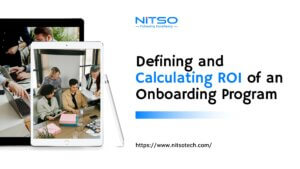Are you struggling to justify the investments made in your HR initiatives? In today’s data-driven business world, measure the ROI of HR initiatives and programs has become a critical necessity. By quantifying the impact of your HR efforts, you can not only validate the resources allocated but also gain valuable insights for continuous improvement.
Measuring Return on Investment (ROI) enables you to demonstrate the strategic value of HR to stakeholders, secure budget approvals, and make informed decisions. It provides a tangible metric to evaluate the effectiveness of initiatives aimed at attracting, retaining, and developing top talent. Whether it’s implementing a new training program, revamping compensation structures, or enhancing employee engagement strategies, calculating the ROI offers a data-driven approach to assessing their impact on organizational performance.
Content On This Page
What is ROI and How is it Calculated for HR Initiatives?
In the ever-evolving business landscape, the role of HR has shifted from a mere administrative function to a strategic partner driving organizational success. As such, it has become increasingly crucial to quantify the impact of HR initiatives and demonstrate their tangible contributions to the bottom line. This is where the concept of Return on Investment (ROI) comes into play.
ROI is a metric that measures the profitability of an investment by comparing the benefits or returns generated against the costs incurred. In the context of HR, ROI helps evaluate the effectiveness of programs, practices, and initiatives aimed at optimizing the workforce and enhancing organizational performance.
The formula for calculating ROI is straightforward: (Benefit – Cost) / Cost x 100.
However, the challenge lies in accurately identifying and quantifying both the benefits and costs associated with HR initiatives, which often involve intangible factors.
Measuring the ROI of HR initiatives can be complex due to the inherent difficulty in isolating the impact of specific initiatives from other organizational factors. Additionally, some benefits, such as improved employee morale or a stronger corporate culture, can be challenging to quantify accurately.
Despite these challenges, embracing an ROI mindset is crucial for HR professionals to demonstrate their strategic value and secure buy-in from stakeholders. By effectively measuring and communicating the ROI of HR initiatives, organizations can make informed decisions, optimize resource allocation, and drive sustainable success.
Benefits of How to Identify and Measure the ROI of HR Initiatives?
- One of the most common benefits sought through HR initiatives is cost savings. This can be achieved through reduced turnover rates, lower recruitment costs, or streamlined processes that enhance operational efficiency. By implementing initiatives that improve employee retention or optimize hiring practices, organizations can realize significant cost savings over time.
- Another crucial benefit is increased productivity. Effective training programs, performance management systems, and employee development initiatives can equip employees with the necessary skills and motivation to perform at their best. Measuring productivity metrics, such as output per employee or project completion times, can provide tangible evidence of the impact of these initiatives.
- Improved retention is another valuable benefit that HR initiatives aim to achieve. Initiatives focused on enhancing employee engagement, fostering a positive work culture, and providing competitive compensation and benefits can contribute to retaining top talent. Tracking metrics like turnover rates, tenure, and the associated costs of replacing employees can quantify the benefits of successful retention efforts.
- Furthermore, enhanced employee engagement is often a key objective of HR initiatives. Engaged employees tend to be more productive, deliver better customer service, and contribute to a positive work environment. Measuring employee engagement through surveys, monitoring absenteeism rates, and tracking customer satisfaction scores can provide insights into the effectiveness of engagement initiatives.
It’s important to note that not all benefits are easily quantifiable. Intangible benefits, such as improved workplace culture, stronger employer branding, and increased innovation, can also contribute to organizational success. While challenging to measure directly, these benefits can be inferred through metrics like employee feedback, external recognition, and the ability to attract top talent.
By carefully selecting and tracking relevant metrics aligned with the objectives of each HR initiative, organizations can effectively identify and quantify the associated benefits. This data-driven approach not only enables accurate ROI calculations but also provides valuable insights for continuously refining and optimizing HR strategies.
What Costs Should Be Considered When Measuring ROI of HR Initiatives?
While quantifying the benefits of HR initiatives is crucial, accurately determining the associated costs is equally important for a comprehensive ROI calculation. These costs can vary widely depending on the nature and scope of the initiative, but they typically fall into several categories.
- One of the most apparent costs is the implementation cost, which includes expenses incurred during the planning, development, and roll-out phases of the initiative. This may encompass costs related to hiring external consultants, purchasing software or tools, conducting training sessions, and allocating internal resources dedicated to the project.
- Beyond the initial implementation, HR initiatives often require ongoing costs to sustain and maintain their effectiveness. These costs can include subscriptions or licenses for software and tools, fees for external service providers, and the salaries or time allocation of HR professionals responsible for managing and monitoring the initiative.
- Additionally, it’s essential to account for opportunity costs, which represent the potential benefits or returns that could have been realized by investing the same resources elsewhere. For example, if an organization invests in a costly leadership development program, the opportunity cost could be the potential revenue or productivity gains that could have been achieved by allocating those resources to other initiatives or operational areas.
- In some cases, HR initiatives may also incur indirect costs, such as temporary productivity losses during the implementation phase or the cost of reallocating resources from other areas of the organization. While these costs may be less tangible, they should still be considered in the overall cost calculation.
- To accurately determine the costs associated with an HR initiative, it’s crucial to adopt a comprehensive approach that accounts for all relevant expenses. This may involve collaborating with finance teams, meticulously tracking expenditures, and forecasting future costs based on the initiative’s projected lifespan and potential scaling requirements.
By thoroughly understanding and quantifying the costs, organizations can better assess the true return on investment and make informed decisions about resource allocation and prioritization of HR initiatives.
How to Set Up an Effective ROI Measurement Process for HR Initiatives?
Effectively measuring the ROI of HR initiatives requires a structured and disciplined approach. Establishing a well-defined ROI measurement process is crucial to ensure accurate and consistent data collection, analysis, and reporting.
- The first step in this process is to clearly define the objectives of the HR initiative. Understanding the specific goals, whether it’s reducing turnover, increasing productivity, or enhancing employee engagement, will guide the selection of appropriate metrics and measurement techniques.
- Next, identify the key metrics that will be used to track progress and quantify the benefits of the initiative. These metrics should be directly aligned with the objectives and may include factors such as turnover rates, absenteeism, employee satisfaction scores, or productivity measures.
- Before implementing the initiative, it’s essential to establish a baseline by collecting and analyzing data on the current state of the organization. This baseline data will serve as a reference point for comparing and measuring the impact of the HR initiative over time.
- Once the initiative is underway, consistent data collection is critical. This may involve leveraging existing HR information systems, conducting surveys or interviews, or implementing specialized tools for tracking relevant metrics. Ensuring data accuracy and completeness is paramount for reliable ROI calculations.
- As data accumulates, regular analysis should be performed to monitor progress, identify trends, and make necessary adjustments to the initiative. This analysis should not only focus on the quantitative metrics but also incorporate qualitative feedback and insights from stakeholders.
- Finally, it’s important to communicate the results effectively to relevant stakeholders. Clear and concise reporting, coupled with data visualization techniques, can help convey the ROI findings in a compelling manner. This transparency and data-driven approach can foster buy-in, secure ongoing support, and enable informed decision-making for future HR initiatives.
Throughout this process, it’s essential to maintain a continuous improvement mindset, regularly reviewing and refining the ROI measurement approach based on lessons learned and evolving organizational needs. Collaboration between HR professionals, finance teams, and other relevant stakeholders can further strengthen the effectiveness of the ROI measurement process.
What Real-World Examples Demonstrate Successful ROI Measurement for HR Initiatives?
To better understand the practical application of measuring the ROI of HR initiatives, it’s helpful to explore real-world case studies and examples from organizations that have successfully implemented this approach. These success stories not only illustrate the tangible benefits but also provide valuable insights into effective strategies and methodologies.
One notable example is the case of a large retail chain that implemented a comprehensive employee engagement program. By conducting regular surveys, analyzing feedback, and introducing initiatives such as recognition programs and flexible work arrangements, the company saw a significant improvement in employee satisfaction and retention rates.
Through careful tracking of metrics like turnover costs, absenteeism, and productivity levels, the organization was able to quantify the benefits of the engagement program. The results showed a substantial ROI, with cost savings from reduced turnover and increased productivity outweighing the investment in the program itself.
Another compelling case study involves a technology company that invested in a leadership development initiative for its mid-level managers. The program focused on enhancing communication, decision-making, and strategic thinking skills through a combination of classroom training, coaching, and on-the-job projects.
To measure the ROI, the company tracked metrics such as employee engagement scores, project success rates, and the career advancement of participants. The results demonstrated a notable improvement in these areas, translating into increased productivity, better team collaboration, and a stronger leadership pipeline.
Furthermore, by calculating the costs associated with the program, including external facilitators, materials, and employee time allocation, the company was able to demonstrate a positive ROI, justifying the investment and paving the way for future leadership development initiatives.
In the realm of talent acquisition, a healthcare organization implemented a streamlined recruitment process and employer branding campaign. By leveraging technology, optimizing candidate sourcing strategies, and promoting their employer value proposition, they successfully reduced time-to-hire and improved the quality of hires.
The ROI calculation for this initiative factored in the cost savings from reduced recruitment agency fees, decreased vacant position costs, and improved retention rates for new hires. The organization not only achieved a positive ROI but also gained a competitive edge in attracting top talent.
These case studies and examples demonstrate the diverse applications of measuring ROI across various HR initiatives and industries. They highlight the importance of setting clear objectives, selecting relevant metrics, accurately capturing costs, and consistently tracking and analyzing data throughout the process.
What are the Best Practices and Tips for Measuring ROI of HR Initiatives?
Measuring the ROI of HR initiatives is a complex and multifaceted process, but adhering to best practices and tips can significantly increase the accuracy and effectiveness of your efforts. Here are some key recommendations to consider:
- Secure stakeholder buy-in: Ensuring that key stakeholders, such as senior management and department heads, are on board with the ROI measurement process is crucial. Their support and commitment can facilitate data collection, resource allocation, and the implementation of necessary changes based on the findings.
- Focus on data quality: The accuracy of your ROI calculations heavily relies on the quality of the data you collect. Establish clear definitions for metrics, implement robust data collection methods, and regularly validate the data to ensure its reliability and completeness.
- Align with organizational goals: When selecting HR initiatives to measure, prioritize those that directly align with the organization’s strategic objectives. This ensures that the ROI findings are relevant and can contribute to achieving broader business goals.
- Communicate effectively: Presenting ROI findings in a clear and compelling manner is essential for gaining traction and driving action. Utilize data visualization techniques, storytelling, and language that resonates with different stakeholder groups.
- Embrace a continuous improvement mindset: Treat ROI measurement as an ongoing process, not a one-time event. Regularly review and refine your approach based on lessons learned, evolving organizational needs, and feedback from stakeholders.
- Leverage technology and automation: Utilize specialized software, analytics tools, and automation to streamline data collection, analysis, and reporting processes. This can enhance efficiency, reduce manual effort, and provide real-time insights.
- Collaborate across teams: Measuring ROI often requires cross-functional collaboration. Foster partnerships with teams such as finance, IT, and operations to ensure a comprehensive understanding of costs, data sources, and organizational impact.
- Prioritize intangible benefits: While quantifying tangible benefits is essential, don’t overlook the importance of intangible factors like employee morale, workplace culture, and employer branding. Incorporate qualitative measures and anecdotal evidence to capture their impact.
- Benchmark and learn from others: Stay informed about industry best practices and learn from the experiences of other organizations that have successfully measured ROI for HR initiatives. Attend conferences, participate in professional networks, and seek guidance from experts.
- Celebrate successes: When you achieve positive ROI results, celebrate and recognize the efforts of those involved. This reinforces the value of the process and encourages continued commitment to data-driven decision-making.
By embracing these best practices and tips, you can enhance the accuracy, credibility, and impact of your ROI measurement efforts, positioning HR as a strategic partner and driving sustainable success for your organization.
Conclusion
Measuring the ROI of HR initiatives is a crucial step towards aligning HR efforts with business objectives and solidifying HR’s position as a strategic partner. By following the strategies and best practices outlined in this guide, you can effectively quantify the impact of your HR programs and demonstrate their contribution to the organization’s bottom line.
Embrace a data-driven mindset and make ROI measurement an integral part of your HR practices. Continuously monitor and refine your approach, leveraging the insights gained to optimize future initiatives and drive sustainable success. Remember, measuring ROI is not just about justifying investments; it’s about maximizing the value of your HR efforts and fostering a high-performing, engaged workforce.
Embark on this journey of measuring ROI, and unlock the true potential of your HR initiatives to propel your organization towards greater heights. The path to success lies in quantifying the impact and making data-driven decisions that align with your business goals.








0 Comments